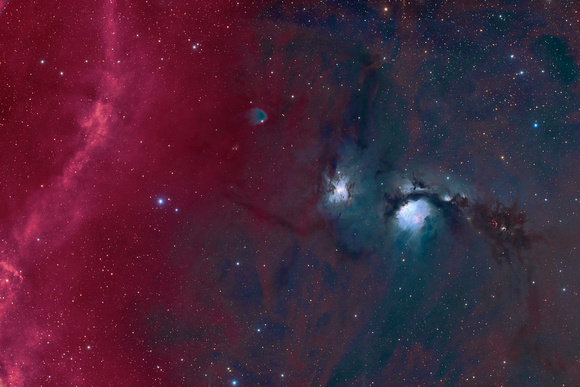Barnards Loop and M78 (Orion) in LHRGB
Barnards Loop and M78
Askar 151phq; AP Mach2 GTO
ASI6200MM, - Baader 6.5nm NB CMOS opt. filters
H: (72 x 450s Bin 1, Gain 200)
R,G,B: (65,63,71 x 180s, Bin 1, Gain 100)
L: (81x150s, Bin 1, Gain 100)
Total integration time = 22.3 hrs (Jan 12,13,14,15 & Feb 4,12,13 2024)
This part of the night sky is special to me as it contains all three kinds of nebulosity – dark, emission, and reflection.
Barnard’s Loop, is an massive arc of emission nebulosity that circles the stars within and surrounding the Great Orion nebula, the Flame nebula, etc., with only a small portion of it captured in this image. It is thought to be part of a massive super-nova remnant and lies between 500 and 1500 lys away. Hydrogen atoms with the Barnard’s loop emit Balmer series spectra after they have been excited by UV radiation from these Orion stars. The primary spectral (colour) intensity peaks are hydrogen alpha red, and hydrogen beta greeny blue. Together these emissions create the red, bordering on magenta colour as captures in this image. These emissions are not only within the bright Barnards loop itself, but vary in intensity throughout the background. Note that it is often stated that hydrogen ions are creating these emissions from the capture of free electrons, but this is not the case – such emissions may be present but these are all in the UV spectrum.
M78 on the RHS of the images consists of reflection nebula. In contrast to emission nebula, these are formed by the mere reflection of existing starlight, and tend to be blue/white in colour. The stars where the visible light originates are often embedded in the molecular clouds that form the reflections. While the distance to the M78 reflection nebulae is purported to 1400 lys, it is unclear to me whether the light source is in front of, behind, or surrounded by Barnards Loop.
Dark Nebulae are formed by the same molecular cloud ingredients that form reflection and emission nebula, but in this case, they are not sources of light – often because they are between the line of sight from stars to us. They are in fact shadows cast in our direction, noted through the dimming and ultimately blotting out of other light, including stars and nebulosity, from deeper in space. The dark nebulosity in this image is very linear in nature, snaking and branching almost all the way across the image. It definitely hides a lot of the reflection nebulosity, but also seems to dim parts of Barnards loop as it crosses in front of it.


